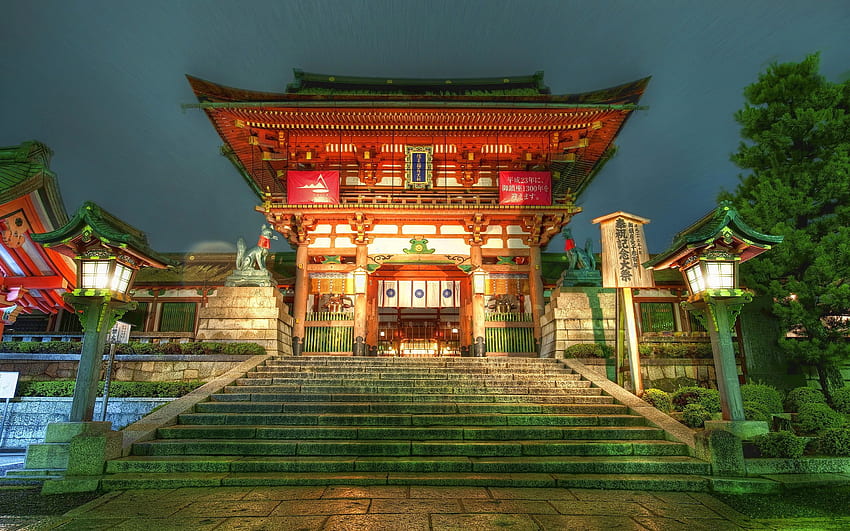
Nestled amid ancient forests and serene landscapes, Shinto shrines stand as gateways to the spiritual world of Japan. These sacred spaces, each with their own unique charm and significance, invite visitors to connect with the divine and immerse themselves in the rich tapestry of Shinto beliefs. From the iconic vermilion torii gates that mark the threshold between the mundane and the sacred, to the tranquil gardens that foster reflection and peace, every shrine embodies a harmony with nature that is central to Shinto philosophy.
Famous Shrine In Japan
As we explore these beautiful sanctuaries, we uncover more than just architectural marvels; we discover living traditions that have shaped Japanese culture for centuries. Each shrine tells a story, from the ancient rituals performed to honor kami, the spirits of nature and ancestors, to the vibrant festivals that celebrate the changing seasons. In this journey through the whispers of the kami, we delve into the essence of Shinto shrines and the profound connection they foster between the natural world and the human spirit.
Historical Significance
Shinto shrines, known as jinja, play an essential role in Japan’s spiritual landscape, embodying the connection between the physical and the divine. Their origins can be traced back to ancient animistic beliefs where natural elements were revered as kami or spirits. Over centuries, these practices evolved into a structured religion with shrines established as sacred spaces where people could engage with their deities. The development of these shrines reflects Japan’s cultural and historical evolution, illustrating the deep-rooted respect for nature and the divine.
Throughout history, Shinto shrines have served not only as places of worship but also as community hubs. They provided a space for gatherings, festivals, and celebrations, solidifying their importance in the social fabric of Japanese life. The architectural styles and designs of shrines evolved, influenced by various periods and local customs, resulting in a rich diversity of shrine forms. This architectural heritage showcases the craftsmanship and artistic expression of different eras, making each shrine not just a spiritual site, but also a historical monument.
The impact of Shinto shrines extends beyond their immediate religious functions. They have been pivotal during significant national events, such as imperial ceremonies, and have played a role in Japan’s identity throughout tumultuous periods, including the Meiji Restoration and World War II. The revival and preservation of these shrines symbolize the resilience of Japanese culture and the ongoing reverence for tradition in modern society. Through the centuries, Shinto shrines have maintained their significance as vital markers of cultural heritage and communal identity.
Architectural Elements
Shinto shrines are renowned for their harmonious architecture that blends organically with nature. At the heart of their design is the use of natural materials such as wood, straw, and stone, which not only reflect the spiritual connection to nature but also ensure that the structures age gracefully, blending further into their surroundings. The simplicity and elegance of this design often evoke a sense of tranquility, inviting visitors to pause and reflect.
One of the most distinctive features of Shinto shrines is the torii gate, which marks the entrance to the sacred space. These gates symbolize the transition from the mundane to the sacred, serving as a powerful reminder of the spiritual journey that begins upon entering a shrine. Typically made of wood or stone, torii gates vary in design and size, each representing the unique characteristics and traditions of the shrine it adorns.
Furthermore, the layout of a Shinto shrine often follows a specific architectural pattern, beginning with the torii gate, followed by a path leading to the honden, or main hall. This sacred space is where the kami, or spirits, are enshrined and worshipped. The honden is usually elevated on stilts, allowing for airflow and preventing moisture from accumulating, emphasizing the relationship between the built environment and nature. Together, these elements create a sacred space that fosters spiritual connection and reverence.
Cultural Practices
Shinto shrines serve as focal points for various cultural practices that are deeply intertwined with the rhythms of daily life in Japan. One of the most prominent customs is the practice of visiting shrines during significant moments, such as New Year’s celebrations, where millions participate in the ritual known as Hatsumode. This event captivates the spirit of renewal and hope as families gather to pray for health, happiness, and prosperity in the coming year. The vibrant atmosphere, filled with food stalls and traditional music, reflects the communal joy surrounding these sacred spaces.
In addition to seasonal celebrations, many shrines are associated with rites of passage, marking important life events. Shinto weddings, for example, often take place in the serene setting of a shrine, emphasizing the spiritual bond within the marriage. Similarly, Shichi-Go-San, a cultural ceremony for children aged three, five, and seven, involves visiting a shrine to celebrate their growth and seek blessings for their future. These practices reinforce the connection between individuals and the divine, illustrating the role of shrines as vital spaces for personal milestones.
Moreover, the practice of rituals and festivals, known as matsuri, showcases the vibrant dedication of local communities to their shrines. These events often involve traditional music, dance, and the carrying of mikoshi, or portable shrines, which embody the presence of the kami. Matsuri not only honor the deities but also strengthen community bonds, as residents come together to participate in the festivities. Through these ceremonies, the sacred nature of Shinto shrines is celebrated, revealing a rich tapestry of cultural heritage that thrives in contemporary Japan.
Natural Surroundings
The natural surroundings of Shinto shrines play a vital role in their spiritual significance. Often nestled within serene forests or alongside flowing rivers, these sacred spaces are designed to harmonize with the environment. The beauty of nature is seen as a manifestation of the kami, the divine spirits revered in Shinto. This deep connection between the shrines and their surroundings fosters a sense of peace and tranquility, inviting visitors to reflect and connect with the divine.
Trees, stones, and water elements are carefully integrated into the shrine’s landscape, each symbolizing various aspects of spirituality. Sacred trees, such as the towering sugi cedar, stand as guardians, while water often flows nearby, representing purification and renewal. The choice of location for many of these shrines is intentional, as the traditions emphasize the importance of being in places where the kami can be felt most strongly. This relationship with nature cultivates an atmosphere of reverence and respect for the natural world.
Visiting a Shinto shrine is not just an act of worship; it is an experience of immersion in the beauty of nature. As people stroll through the serene pathways, they are constantly reminded of the interconnectedness of life and the divine. The colors of the seasons, the sounds of rustling leaves, and the gentle flow of water create a symphony that elevates the spirit. In this way, the natural surroundings of Shinto shrines enhance their sacred beauty, allowing visitors to feel the whispers of the kami all around them.


